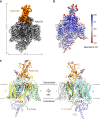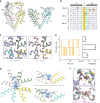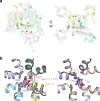Structure of the human sodium leak channel NALCN in complex with FAM155A
- PMID: 33203861
- PMCID: PMC7672056
- DOI: 10.1038/s41467-020-19667-z
Structure of the human sodium leak channel NALCN in complex with FAM155A
Abstract
NALCN, a sodium leak channel expressed mainly in the central nervous system, is responsible for the resting Na+ permeability that controls neuronal excitability. Dysfunctions of the NALCN channelosome, NALCN with several auxiliary subunits, are associated with a variety of human diseases. Here, we report the cryo-EM structure of human NALCN in complex with FAM155A at an overall resolution of 3.1 angstroms. FAM155A forms extensive interactions with the extracellular loops of NALCN that may help stabilize NALCN in the membrane. A Na+ ion-binding site, reminiscent of a Ca2+ binding site in Cav channels, is identified in the unique EEKE selectivity filter. Despite its 'leaky' nature, the channel is closed and the intracellular gate is sealed by S6I, II-III linker and III-IV linker. Our study establishes the molecular basis of Na+ permeation and voltage sensitivity, and provides important clues to the mechanistic understanding of NALCN regulation and NALCN channelosome-related diseases.
Conflict of interest statement
The authors declare no competing interests.
Figures







Similar articles
-
Structure of the human sodium leak channel NALCN.Nature. 2020 Nov;587(7833):313-318. doi: 10.1038/s41586-020-2570-8. Epub 2020 Jul 22. Nature. 2020. PMID: 32698188
-
Structure of voltage-modulated sodium-selective NALCN-FAM155A channel complex.Nat Commun. 2020 Dec 3;11(1):6199. doi: 10.1038/s41467-020-20002-9. Nat Commun. 2020. PMID: 33273469 Free PMC article.
-
Structural architecture of the human NALCN channelosome.Nature. 2022 Mar;603(7899):180-186. doi: 10.1038/s41586-021-04313-5. Epub 2021 Dec 20. Nature. 2022. PMID: 34929720
-
New insights into the physiology and pathophysiology of the atypical sodium leak channel NALCN.Physiol Rev. 2024 Jan 1;104(1):399-472. doi: 10.1152/physrev.00014.2022. Epub 2023 Aug 24. Physiol Rev. 2024. PMID: 37615954 Review.
-
Selectivity filters and cysteine-rich extracellular loops in voltage-gated sodium, calcium, and NALCN channels.Front Physiol. 2015 May 19;6:153. doi: 10.3389/fphys.2015.00153. eCollection 2015. Front Physiol. 2015. PMID: 26042044 Free PMC article. Review.
Cited by
-
The Effect of Calcium Ions on Resting Membrane Potential.Biology (Basel). 2024 Sep 23;13(9):750. doi: 10.3390/biology13090750. Biology (Basel). 2024. PMID: 39336177 Free PMC article.
-
Modulating Ca2+ influx into adrenal chromaffin cells with short-duration nanosecond electric pulses.Biophys J. 2024 Aug 20;123(16):2537-2556. doi: 10.1016/j.bpj.2024.06.021. Epub 2024 Jun 21. Biophys J. 2024. PMID: 38909279
-
Unplugging lateral fenestrations of NALCN reveals a hidden drug binding site within the pore region.Proc Natl Acad Sci U S A. 2024 May 28;121(22):e2401591121. doi: 10.1073/pnas.2401591121. Epub 2024 May 24. Proc Natl Acad Sci U S A. 2024. PMID: 38787877 Free PMC article.
-
Role of sodium leak channel (NALCN) in sensation and pain: an overview.Front Pharmacol. 2024 Jan 11;14:1349438. doi: 10.3389/fphar.2023.1349438. eCollection 2023. Front Pharmacol. 2024. PMID: 38273833 Free PMC article. Review.
-
The Na+ leak channel NALCN controls spontaneous activity and mediates synaptic modulation by α2-adrenergic receptors in auditory neurons.Elife. 2024 Jan 10;12:RP89520. doi: 10.7554/eLife.89520. Elife. 2024. PMID: 38197879 Free PMC article.
References
Publication types
MeSH terms
Substances
LinkOut - more resources
Full Text Sources
Other Literature Sources
Molecular Biology Databases
Miscellaneous


